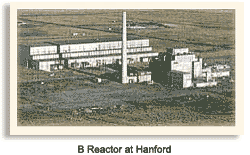The Hanford reservation in eastern Washington State covered more than 600 square miles and had 50 miles of the Columbia River running through it. The site was selected in 1942 for the purpose of producing plutonium for the Manhattan Project. The world's first plutonium production reactor, designated the B Reactor, was designed by Enrico Fermi and other scientists at the University of Chicago. Construction was the responsibility of the Army Corps of Engineers, while the facilities were assigned to the DuPont chemical company.
The first step was to remove the small number of civilians who lived in the area, mostly clustered along the Columbia. The eviction notice came without warning on March 6, 1943. About 1,500 residents were displaced. Neither they nor the workers who came afterwards were told what the purpose of the project was until after the bomb was dropped on Hiroshima.
 Later in 1943, the B Reactor began producing plutonium. Working in conjunction with the T Plant, enough plutonium was produced and refined for the first test at Trinity in July, 1945, and for the second atomic bomb, which fell on Nagaski in August. Following the war, B Reactor was mothballed from 1946 to 1948, but it was then restarted and operated continuously until February, 1968.
Other reactors were built over the years, as Hanford remained the source of plutonium for America's nuclear weapons program. The wartime mentality placed a premium on production and placed less importance on the environment. As a result, although plutonium production ceased in 1990, radioactive waste stored on the reservation is still being processed. A complete cleanup of Hanford will take decades and billions of additional dollars.
Later in 1943, the B Reactor began producing plutonium. Working in conjunction with the T Plant, enough plutonium was produced and refined for the first test at Trinity in July, 1945, and for the second atomic bomb, which fell on Nagaski in August. Following the war, B Reactor was mothballed from 1946 to 1948, but it was then restarted and operated continuously until February, 1968.
Other reactors were built over the years, as Hanford remained the source of plutonium for America's nuclear weapons program. The wartime mentality placed a premium on production and placed less importance on the environment. As a result, although plutonium production ceased in 1990, radioactive waste stored on the reservation is still being processed. A complete cleanup of Hanford will take decades and billions of additional dollars.